

Captain (Dr.) Julian Ward, MD (March 15, 1927 - August 13, 1962 ) was an American physician who made contributions to aerospace medicine and the Mercury space program. [1] [2] [3] [4] [5]


Captain (Dr.) Julian Ward, MD (March 15, 1927 - August 13, 1962 ) was an American physician who made contributions to aerospace medicine and the Mercury space program. [1] [2] [3] [4] [5]
On March 15, 1927, Julian Elvis Ward Jr. was born in Wichita Falls, Texas. In 1952, he received M.D., M.S. (pathology, cum laude) degrees from Baylor College of Medicine. He completed an internship at San Francisco City-County Hospital. [1]
In 1953 Ward entered US Air Force as First Lieutenant. He helped develop a partial pressure suit (prototype space suit) at Gunter AFB, near Montgomery, Alabama, while serving as Chief of the Flight Surgeon Section, School of Aviation Medicine, Gunter Branch. In 1955, he received a Master of Public Health (M.P.H.) degree from Harvard University School of Public Health, M.P.H. (cum laude). In 1958 Ward was named Deputy Chief, School of Space Medicine, Randolph Air Force Base, San Antonio, Texas. From 1959 to 1962, Major Ward was Commander of the 49th Tactical Hospital at Spangdahlen AFB, Germany. During this assignment, he monitored the safety of manned space flights, including that of John Glenn’s 1962 Friendship 7 flight, from a telemetry station in the Canary Islands. [1]
In a 1958 North Carolina newspaper article, "Medical Men Say Space Flight Might Be Safer Than Columbus", Ward described weightlessness as the biggest mystery in space medicine. [6] Ward's involvement in the space program should be seen in the context of the Cold War in which the United States was engaged following WWII and President Kennedy's dramatic announcement of US commitment to the goal of landing a man on the Moon before the end of the 1960s. [1]
Ward explored the unknown as a scientist and pioneer, initially using Earth-bound isolation chambers and short flights into the upper atmosphere how humans could travel safely in space, ensuring those who might attempt a space voyage that they would be protected from its dangers. Besides the Earth-bound experiments with humans, he monitored the health of animals (mice and chimpanzees) in suborbital and orbital flights. He tracked the first Earth sub-orbital and orbital manned space missions in Project Mercury from Tenerife in the Canary Islands, including the first US orbital space mission of John Glenn in February 1962. Ward explored the possibility of human life in a condition of weightlessness, human life beyond the limitations and restrictions of Earth. [1]
Ward authored thirteen professional papers and co-author two others on a diversity of topics. [1] [5] [7] [8] One publication that achieved widespread attention was "The True Nature of the Boiling of Body Fluids in Space", [5] a paper presented at a symposium on Medical Problems of Space Flight at the US Air Force School of Aviation Medicine, January 19–20, 1956. The paper was published in Aviation Medicine in October 1956. It introduced the term "space ebullism" for the vaporization of body fluids in space at body temperatures. [1]
On August 13, 1962, Ward died at age 35 as a result of injuries from a plane crash in Germany. [1]
The Julian E. Ward Memorial Award was established and sponsored by the Society of US Air Force Flight Surgeons in memory of its first member to lose their life in an aircraft accident, and to honor all flight surgeons whose lives are lost in the pursuit of flying activities related to the practice of aerospace medicine. The award is given annually for superior performance and/or outstanding achievement in the art and science of aerospace medicine during residency training. [9]

Project Mercury was the first human spaceflight program of the United States, running from 1958 through 1963. An early highlight of the Space Race, its goal was to put a man into Earth orbit and return him safely, ideally before the Soviet Union. Taken over from the US Air Force by the newly created civilian space agency NASA, it conducted 20 uncrewed developmental flights, and six successful flights by astronauts. The program, which took its name from Roman mythology, cost $2.57 billion. The astronauts were collectively known as the "Mercury Seven", and each spacecraft was given a name ending with a "7" by its pilot.

A flight surgeon is a military medical officer practicing in the clinical field of aviation medicine. Although the term "flight surgery" is considered improper by purists, it may occasionally be encountered.

The Lyndon B. Johnson Space Center (JSC) is NASA's center for human spaceflight, where human spaceflight training, research, and flight control are conducted. It was renamed in honor of the late US president and Texas native, Lyndon B. Johnson, by an act of the United States Senate on February 19, 1973.

Norman Earl Thagard, is an American scientist and former U.S. Marine Corps officer and naval aviator and NASA astronaut. He is the first American to ride to space on board a Russian vehicle, and can be considered the first American cosmonaut. He did this on March 14, 1995, in the Soyuz TM-21 spacecraft for the Russian Mir-18 mission.

William Edgar Thornton was an American NASA astronaut. He received a Bachelor of Science degree in physics from University of North Carolina and a doctorate in medicine, also from UNC. He flew on Challenger twice, the STS-8 and STS-51-B missions.

A reduced-gravity aircraft is a type of fixed-wing aircraft that provides brief near-weightless environments for training astronauts, conducting research and making gravity-free movie shots.

Aviation medicine, also called flight medicine or aerospace medicine, is a preventive or occupational medicine in which the patients/subjects are pilots, aircrews, or astronauts. The specialty strives to treat or prevent conditions to which aircrews are particularly susceptible, applies medical knowledge to the human factors in aviation and is thus a critical component of aviation safety. A military practitioner of aviation medicine may be called a flight surgeon and a civilian practitioner is an aviation medical examiner. One of the biggest differences between the military and civilian flight doctors is the military flight surgeon's requirement to log flight hours.

Artificial gravity is the creation of an inertial force that mimics the effects of a gravitational force, usually by rotation. Artificial gravity, or rotational gravity, is thus the appearance of a centrifugal force in a rotating frame of reference, as opposed to the force experienced in linear acceleration, which by the equivalence principle is indistinguishable from gravity. In a more general sense, "artificial gravity" may also refer to the effect of linear acceleration, e.g. by means of a rocket engine.

Venturing into the environment of space can have negative effects on the human body. Significant adverse effects of long-term weightlessness include muscle atrophy and deterioration of the skeleton. Other significant effects include a slowing of cardiovascular system functions, decreased production of red blood cells, balance disorders, eyesight disorders and changes in the immune system. Additional symptoms include fluid redistribution, loss of body mass, nasal congestion, sleep disturbance, and excess flatulence. Overall, NASA refers to the various deleterious effects of spaceflight on the human body by the acronym RIDGE.
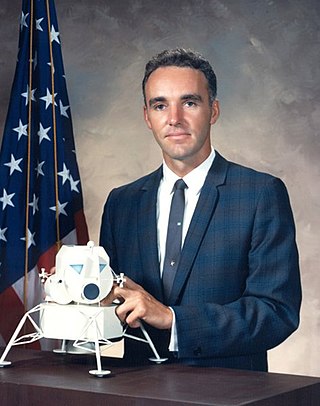
Duane Edgar "Doc" Graveline was an American physician and NASA astronaut. He was one of the six scientists selected in 1965, in NASA's fourth group of astronauts, for the Apollo program. He was best known for being immersed in water for seven days as part of his zero gravity deconditioning research while working as a United States Air Force (USAF) research scientist.
Ebullism is the formation of gas bubbles in bodily fluids due to reduced environmental pressure, for example at high altitude. It occurs because a system of liquid and gas at equilibrium will see a net conversion of liquid to gas as pressure lowers; for example, liquids reach their boiling points at lower temperatures when the pressure on them is lowered.
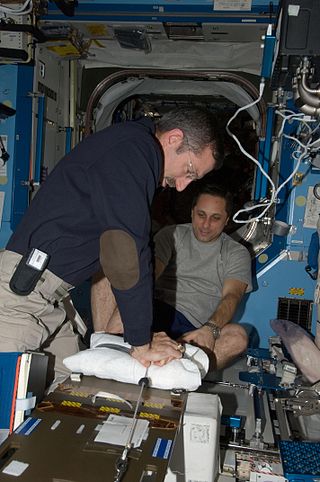
Space medicine is a specialized field under aerospace medicine that focuses on the medical care of astronauts and spaceflight participants. The spaceflight environment poses many unique stressors to the human body, including G forces, microgravity, unusual atmospheres such as low pressure or high carbon dioxide, and space radiation. Space medicine applies preventive medicine, population health, environmental health, and clinical medicine to medically screen and certify individuals for space flight; maintain their health before, during, and after space flight; and inform vehicle systems design to minimize the risk to human health and performance while meeting mission objectives.
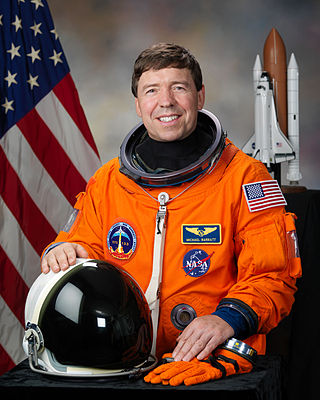
Michael Reed Barratt is an American physician and a NASA astronaut. Specializing in aerospace medicine, he served as a flight surgeon for NASA before his selection as an astronaut, and has played a role in developing NASA's space medicine programs for both the Shuttle-Mir Program and International Space Station. His first spaceflight was a long-duration mission to the International Space Station, as a flight engineer in the Expedition 19 and 20 crew. In March 2011, Barratt completed his second spaceflight as a crew member of STS-133. Barratt will pilot the SpaceX Crew-8 mission in Spring 2024.

The 311th Human Systems Wing is an inactive wing of the United States Air Force. It was stationed at Brooks City-Base in San Antonio, Texas.

Weightlessness is the complete or near-complete absence of the sensation of weight. It is also termed zero gravity, zero G-force, or zero-G. Micro-g environment is more or less synonymous, with the recognition that g-forces are never exactly zero.

Serena Maria Auñón-Chancellor is an American physician, engineer, and NASA astronaut. She visited the ISS as a flight engineer for Expedition 56/57 on the International Space Station.

Space nursing is a specialty that works with astronauts to determine medical fitness for their missions, equips NASA team members to handle emergencies in orbit and researches the effects of space travel on the human body. The career got its start during the space race of the 1960s and has grown—both in terms of number of people in the field and knowledge base—ever since. Research conducted by medical professionals in the aeronautics field has led to many breakthroughs in disease treatment of earthbound patients and the discipline continually develops new technology to make space medicine more effective.
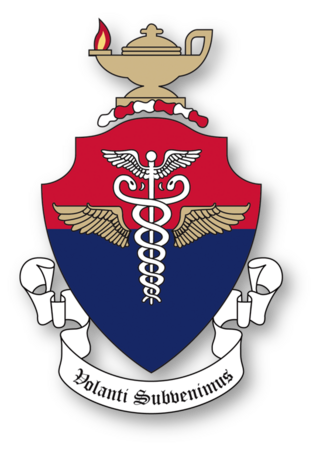
The United States Air Force School of Aerospace Medicine (USAFSAM) is the United States Air Force (USAF) organization focused on education, research, and operational consultation in aerospace and operational medicine. USAFSAM was founded in 1918 to conduct research into the medical and physiologic domains related to human flight, and as a school for medical officers trained to support military aviation operations, later coined as flight surgeons. The school supported early military aviation from World War I through the evolution of aviation and into the modern era. USAFSAM conducted medical research and provided medical support for the initial US space operations beginning in 1947 through the establishment of NASA in 1958. After the creation of NASA, USAFSAM continued to actively support civilian and military manned space missions through clinical and physiologic research. USAFSAM is one of the oldest continually operating school for flight surgeons and other operational medical personnel of its kind in the world. USAFSAM is located in Dayton, Ohio at Wright-Patterson Air Force Base, and is part of the 711th Human Performance Wing and the Air Force Research Laboratory (AFRL).
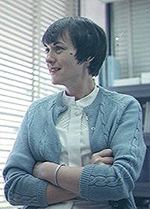
Dolores B. "Dee" O'Hara was the first aerospace nurse to NASA's first astronauts, laying the foundation to the field of Space nursing. O'Hara was the official nurse to the Mercury Seven astronauts and their families, continuing to support the Gemini Program, Apollo astronauts and Skylab.
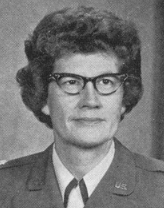
Sarah Elizabeth Beard was an American medical researcher, trained as a nurse. She retired in 1978 as a colonel in the United States Air Force.